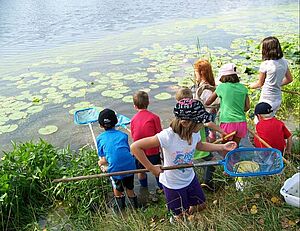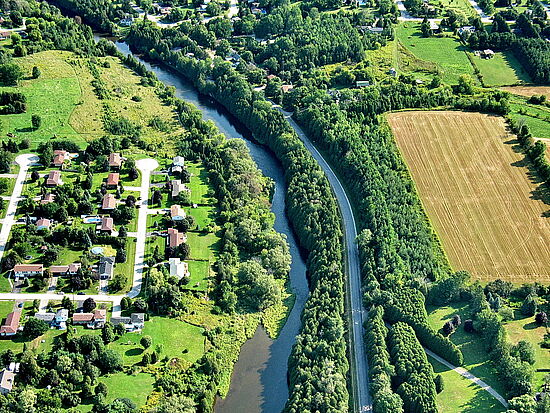Highlights of Conservation Ontario’s submission to the Environmental Registry Posting:Modernizing Conservation Authority Operations – the Conservation Authorities Act
Proposed Provincial changes to the mandate of conservation authorities is very challenging for us because if we want to continue to build healthy watersheds and people, we need the government to understand and agree with the value of watershed management.
The Province proposes limiting the scope of CA work and labelling it either ‘mandatory’ and ‘non-mandatory’. This has the potential for making it much more difficult to deliver on a combination of watershed-based programs and services that together successfully protect the health and safety of Ontarians.
Effective flood management, drinking water source protection and climate change adaptation can’t be delivered by piecing together a patchwork of unrelated projects, programs or services. It needs to be planned and implemented on a watershed basis.
We get it – conservation authorities are not easily understood.
CAs are spread across the province, they come in different sizes, vary in complexity, and they don’t always offer all the same programs. But this is a GOOD thing. They respond to local needs and they deliver watershed-based programs that provide province-wide environmental, economic and health benefits.
The concept of watershed management and how it works also isn’t very ‘user-friendly’ for most people. But it works.
Partnering with conservation authorities, Ontario has a flood management system and a source water protection system that are the best in Canada. With a watershed-wide approach, we’re able to identify and deal with problems early, before they become much more expensive or even impossible to manage. We’re able to link what activities are happening in the watershed that threaten or impact important natural resources such as water.
Oh, and it costs approximately $30 per Ontario household per year for all the CAs’ programs and services.1
Bottom line: conservation authority watershed management programs keep people safe and help all levels of government to avoid the higher costs of a poorly managed environment.
Conservation Ontario’s Submission
Conservation Ontario has completed a review of the government’s proposed changes in the Environmental Registry posting (Modernizing Conservation Authority Operations) and the proposed legislative amendments to the Conservation Authorities Act which was just updated at the end of 2017.
We would have appreciated more time to pull our comments together. Conservation authorities have been challenged to consult with their Boards and member municipalities in the short timeframe provided especially since a number of them have been working flat-out for the past few weeks, helping their communities and homeowners to manage significant flooding problems. It was also surprising to have to turn our efforts to the proposed actual legislative changes to the Conservation Authorities Act which were posted mid-way through the consultation period.
Notwithstanding these challenges we’ve developed a detailed response to the posting and we’d like to pull from this and share four priorities:
- The watershed approach is missing. Conservation and management of CA lands, alone, will not protect Ontario’s drinking water nor will it prevent disastrous and costly flooding. This requires a ‘watershed’ approach that links activities throughout the watershed to both water and land-based natural resources.
We recommend adding a new priority in the mandatory program areas: ‘Conserving Natural Resources’ which includes watershed management programs, - The Province needs to allow the CAs to develop a more flexible and streamlined budgetary process with the municipalities in order to avoid onerous red tape that will result for CAs and municipalities if core watershed management activities are categorized as non-mandatory and require individual Municipal Council agreement,
- The Province needs to continue investing in mandatory CA programs and services as part of their responsibility to safeguard the health and safety of Ontarians, and
- More consultation is needed with conservation authorities, municipalities, and stakeholders before moving forward.
Add ‘Conserving Natural Resources’ to the list of mandatory program areas and support the inclusion of watershed management programs and services
The Province currently proposes clustering the mandatory programs and services eligible for municipal levy into four buckets:
- Natural Hazards (Management)
- Conservation and Management of CA (owned) Lands
- Drinking Water Source Protection
- Lake Simcoe Protection Plan
We feel it is essential to add a fifth one: ‘Conserving Natural Resources’ which would specifically incorporate the broader watershed management role that Conservation Authorities have provided since their inception and which is supported in both the current Conservation Authorities Act and the government’s ‘Made-in-Ontario Environmental Plan’.
 Conservation authority (owned) lands are important. They usually include a watershed’s most ecologically sensitive and robust areas, and they frequently help to reduce or prevent flooding. You often find important natural features such as moraines and escarpments. They provide habitat for plants, fish, wildlife, birds and pollinators which are essential for healthy biodiversity and for the contribution they play to supporting our food chains. Conservation lands also protect sources of drinking water and important tracts of greenspaces with forests, wetlands and grasslands which help to reduce the impacts of climate change such as heat and flooding. Again, they are important but they are only a small segment of an entire watershed.
Conservation authority (owned) lands are important. They usually include a watershed’s most ecologically sensitive and robust areas, and they frequently help to reduce or prevent flooding. You often find important natural features such as moraines and escarpments. They provide habitat for plants, fish, wildlife, birds and pollinators which are essential for healthy biodiversity and for the contribution they play to supporting our food chains. Conservation lands also protect sources of drinking water and important tracts of greenspaces with forests, wetlands and grasslands which help to reduce the impacts of climate change such as heat and flooding. Again, they are important but they are only a small segment of an entire watershed.
The conservation of CA lands, alone, will not protect Ontario’s drinking water nor will it prevent disastrous and costly flooding. This requires a variety of connected, watershed-based programs and services which are mapped out across all the municipalities through collaboratively developed watershed management plans or strategies.
Watershed management provides the necessary understanding of the overall health of the watershed and subsequently guides conservation and management actions needed to ensure the health of our lands and waters. For example, the Conservation Authorities’ watershed studies and their monitoring and reporting activities are very critical to informing strategic local and provincial decision-making. Data from the provincial water monitoring programs is collected, analyzed and shared by conservation authorities with many partners. This information helps all levels of government to achieve multiple watershed objectives such as climate change mitigation and adaptation, flood prevention, reduction and mitigation, safe drinking water and healthy Great Lakes.
The same data is also used for watershed report cards and water budgets. Watershed report cards inform residents about the state of watersheds across the province. Water budgets determine just how much water is available in the watershed today and into the future, as well as identifying what activities are occurring in the watershed that may impact the quality or supply of water. When consolidated with land information, this data helps to support climate and flood event modelling as well as identify watershed stressors that can present future risks to water quality and supply.
Further, if you want to make a difference in the watershed, you need to engage the people  who live and work there. Other types of CA watershed management activities that achieve this include outdoor recreation, environmental education, and, rural and urban stewardship with local landowners and agencies that improves and protects water quality and quantity through restoration, rehabilitation and green infrastructure.
who live and work there. Other types of CA watershed management activities that achieve this include outdoor recreation, environmental education, and, rural and urban stewardship with local landowners and agencies that improves and protects water quality and quantity through restoration, rehabilitation and green infrastructure.
These activities are foundational to delivering on all of the core mandatory programs and can be captured in a new mandatory program and service: Conserving Natural Resources.
A more flexible and streamlined budgetary process is needed for CAs and municipalities
Conservation authorities are currently provided with transfer payments by the Province for provincially mandated programs which includes natural hazards management and drinking water source protection.
However, on the average, most of the conservation authorities’ funding is provided by municipalities, followed closely by self-generated funding through fees, project grants and other sources. The Province is proposing to limit what CAs can levy municipalities by dividing the conservation authorities’ programs and services into ‘mandatory’ and ‘non-mandatory’. Additional red tape and delays will be created for CA staff, CA Board members and municipalities themselves if core watershed management programs are categorized as non-mandatory and require individual Municipal Council agreement.
It would be better to allow municipalities and CAs to develop a more flexible and streamlined approach to obtain municipal support for both mandatory and non-mandatory programs and services.
The Province needs to continue investing in conservation authority mandatory programs and services
Transfer payments to conservation authorities for natural hazards management and drinking water source protection need to continue. The Province has stated it has an obligation to ensure there is frontline support for critical programs that protect the health and safety of Ontarians. The conservation authority flooding and drinking water programs fall easily within this category.
Conservation authorities are scrambling this year to make up for the impacts of the cuts to their budgets – especially since they are occurring part way through a fiscal year when other funding support and programs and already been established.
As well, Municipal mayors’ organizations have issued statements identifying provincial cuts, including those to CA budgets, as downloading by the Province. The Province can prevent any further burden on municipal budgets by continuing to invest in the remaining CA transfer payments.
We need the Province to consult on these changes with conservation authorities, municipalities, and other stakeholders
To ensure that critical watershed management programs and services are being identified as mandatory, we suggest that the Province consult further with conservation authorities and others on the implementation details. Conservation Ontario and the Conservation Authorities have a lot of expertise to share which will help to get things right and ensure that we maintain the efficiencies of the watershed-based approach to natural resource management.
Author: Bonnie Fox, Manager of Policy and Planning and Conservation Ontario staff
1 Based on the cost of all CA expenditures, not just provincial transfer payments.
